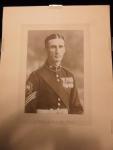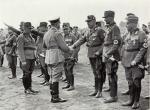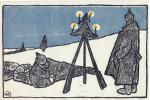-
Posts
2,143 -
Joined
-
Last visited
-
Days Won
10
Content Type
Profiles
Forums
Blogs
Gallery
Events
Store
Everything posted by Odulf
-
The badges are collar badges. The size of the crown (for major and up) defines the size of the badges. Also, the Leichestershire cap badge is different, the wreath is not close as is the case with this badge. However, it is puzzeling how collar badges ended up in Norway, because to my knowledge, the British troops (all ranks!) who were sent there all wore battle dress, and these collar badges were worn on the service dress in bronze by officers or in brass by other ranks. Yes, also, orher ranks wore the woolen service dress, but of a course material, including collar badges, however these were no longer issued to troops who went overseas. Some troops of the BEF went to France wearing woolen service dress, but these were rapidly changed by the 37 pattern battle dress.
-

Royal Navy 1915 Trio + LSGC RMLI/RM
Odulf replied to Odulf's topic in Great Britain: Orders, Gallantry, Campaign Medals
Thanks Mervyn, and Tony for this useful link. I have his Service Records now. At first glance noting spectacular. With a short break between 1935 and1938 he served from 1911 (enlisted as a Bugler) until discharged in September 1945 (as CSM, aged 49), so he must have qualified also for the War and Defence Medals, at least. However these are not mentioned in the Service Records. In 1931 he claimed the MSM, but this was not recommended. During the Great War he served in Chatham and as a fleet marine o/b HMS Duncan (battleship in the 6th Battle Sqdn) from Aug 1914 to Mar 1916 and in HMS Lancaster from Mar 1916 to mid Nov 1918 in the Pacific Fleet. It is always very satisfying to reunite medals etc. when a group was broken up. Sometimes by dealers or collectors, but also when the medals were divided amongst the children after their father died. -
At present I am, again, involved in 3rd Reich stuff, mainly dating pre 1940. In the past I was the custodian of a vast collection of RN medals to many campaigns and finaly to the complement of H.M. Royal Yachts, and I still maintain a large collection of RN insignia. But the set of medals, which got me going in collecting British Naval medals, and which kept me going for 30 years, was this little insignificant group, which I bought at an OMRS-Convention many decades ago, for a few pennies. After more than 30 years, and Internet, nothing has come up do disclose the man behind the medals, but a named photo I picked up in Camden Market (and which brought me over the moon!). The set: 1914/15 Trio (named to CH.16972 S.J. Dunk, Cpl. RMLI Naval LS&GC (straight suspender), (named to CH.16972 S.J. Dunk, Cr.Sgt. RM Many of the records have been destroyed, but I would like to know about his career and development in the RM. Was he a "run of the mill man", who pulled his weight but nothing more, or was he - by carreer and fate - involved in actions and escapades for which no medals were given, but that made history change? At least I am pleased that the medals have a face, a slight fact most medals have to do without.
-

I want that flag........
Odulf replied to dante's topic in Germany: Weimar Republic & Deutsche Freikorps
Imitating skulls -
A very nice photo of Hitler greeting some Generalarbeitsführer at the Reichsparteitag 1935, with Hierl standing next to him. From right to left: - Max Prenzel - AG XIII - Hermann Wagner - AG XVIII - Eduard Helff - AG XXVIII - Wilhelm von Alten - AG XV - Wilhelm Neuerburg - AG XXII (he lost his right arm and so he is greeting with his left arm) - unidentified - unidentified Generalarbeitsführer, without the armshield and unlike the others he is wearing his ribbon bars instead of full size gongs. If any of the members has any furter information or remarks, please share it here.
-

Unidentified Early German Panzer..... Or not?
Odulf replied to Odulf's topic in Armour, Vehicles, Ships & Aircraft
That is a very interesting view indeed, I never thought of that... -

Unidentified Early German Panzer..... Or not?
Odulf posted a topic in Armour, Vehicles, Ships & Aircraft
For quite some time I have this post card size photo with two armoured vehicles, each with a gun turret. The decals lead me to believe these are German Panzer, and to my idea (and limited literature) the only candidate could be the "Leichter Traktor", dating from 1926. However, the vehicles in the photo are in many details different from the picture in my book [Die deutschen Panzer 1926-1945, F.M. von Senger und Etterlin]. Can any of the Genlemen shine a light on this, please? -
-
-
-
-
-
-
An 1915 Austrian Christmas card, showing a cozy corner in a dug out, with the good old emperor on the wall.
-
Both the Allied and Axis forces thought that they would be home before Christmas, in fact it took four Christmasses. All parties produced Christmas cards with military images, but at the front a Christmas armistice was not appreciated by the generals. Show your Christmas ephimeria. please. Kicking off with two Kaiserliche Marine postcards
-

Heer Generalmajor Soldbuch
Odulf replied to hucks216's topic in Germany: Third Reich: Research, Documentation & Photographs
Very nice catch! -
Can you please tell us if it is painted or embroidered or whatever? To me it looks like it was embroidered... and matches the size of a general naval officers breast eagle. Not very exiting... It could have been glued on any material for whatever reason.... What is the glue like? (modern or ancient?) Value? To my opinion, whatever...
-
In the centre he wears a frock coat (Rock) with shoulder boards and on the sleeve braids for an Oberleutnant zur See. I would date all photos between about 1905 and 1918. This significant style of carton (supporting the picture) is mainly typical for Germany and Russia between about 1905 and 1919 (depending on the fashionability of the photographer and the wishes of the orderer). Art deco infuenced commercial photo albums for this rather narrow type of photos, which was not popular in all "civilized" nations. It included a standarisation, and an interested public, this was about as balanced as modern choices for Apple or Micorsoft. Also the postcard size challenged the market, and that format won the race, as it was more popular, cheaper and with the introduction of the postcard, became a direct hit! This, however, killed the specific skills of the, so far and in many ways excellent, photographer, for every Tom, Dick and Harry set up stalls and competed for cheap and mobile photographs. To us, it may be interestin to know that about photography there is a lot to mention... I love these longer types of the previous Carte Visite, because not all photographers had the equipment to work out an image in the best fashion. It also tells that the "sitter" had some cash, because a simple postcard size was easier and cheaper. All this in a time when photography was not as common as today.






















